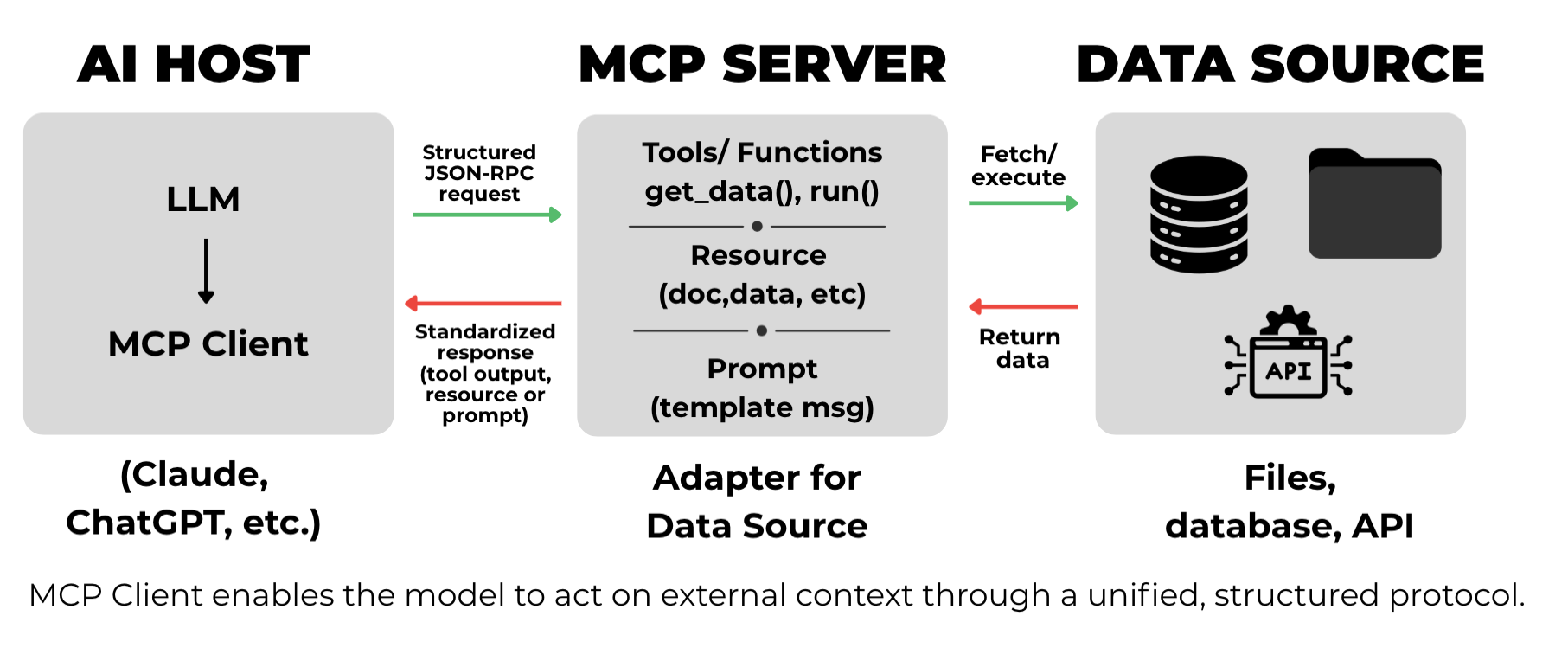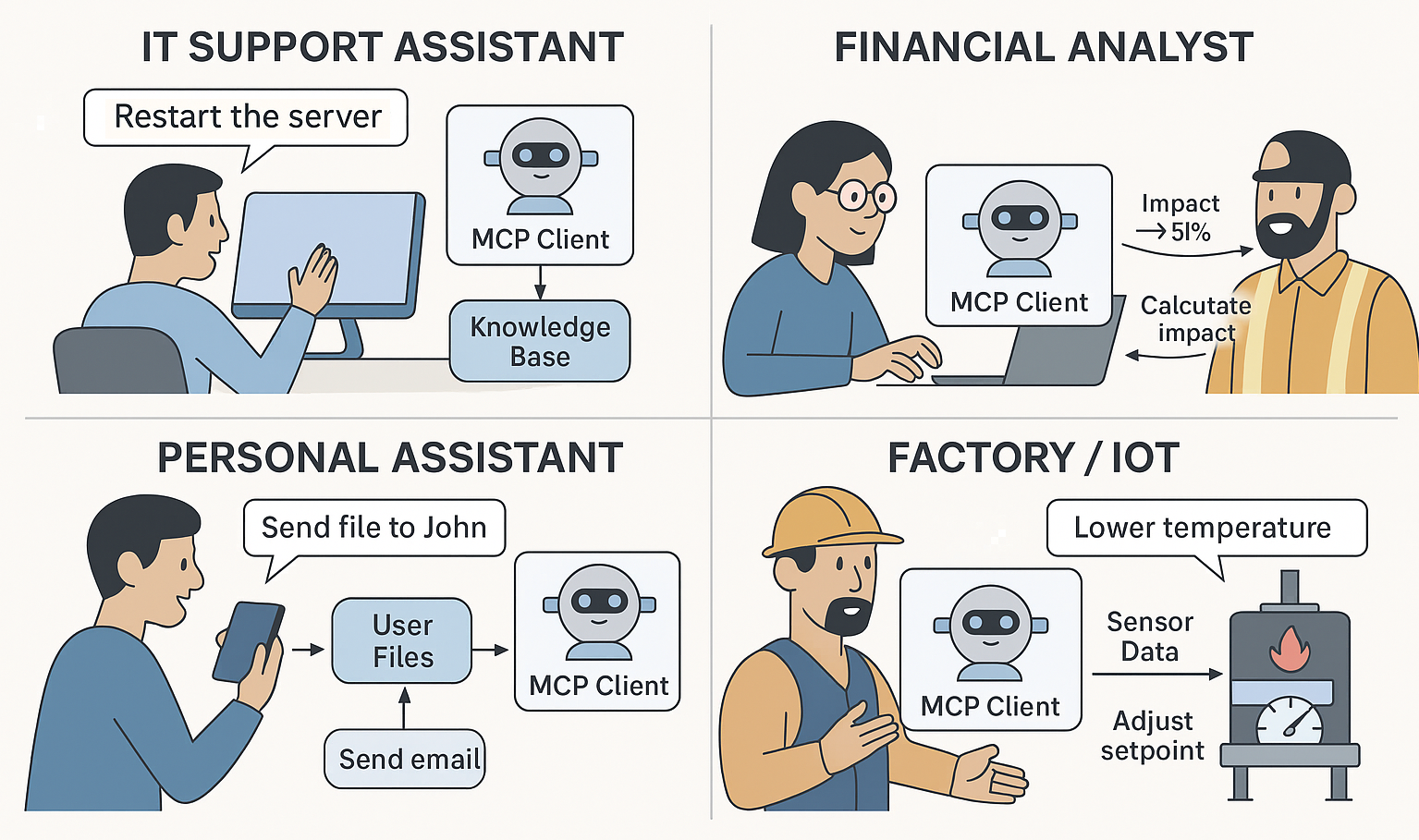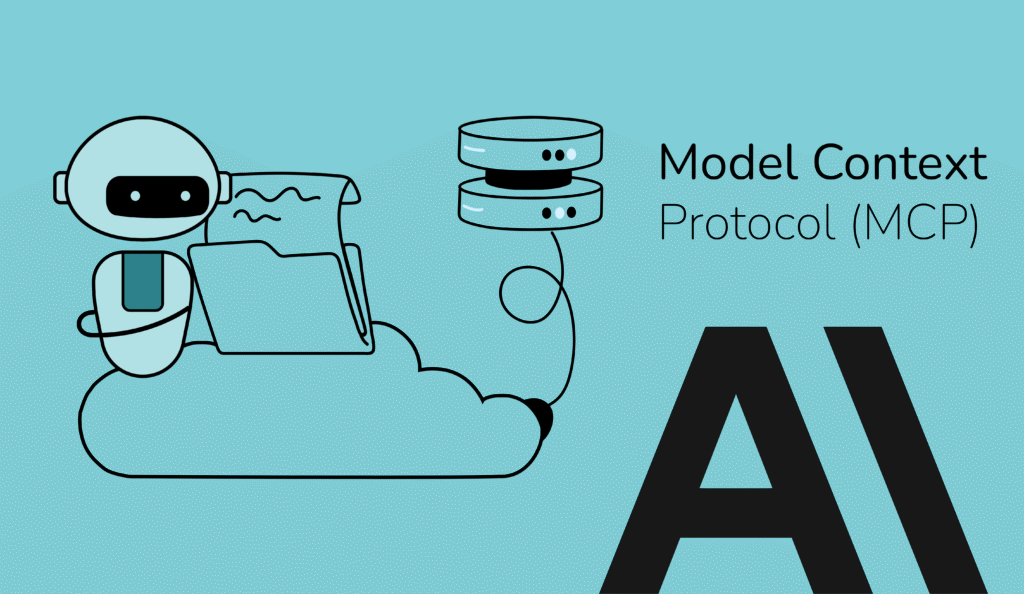Table of Content
- MCP Technical Architecture: Client, Server and Standardized Communication
- Continuous Context Management: From Isolated Queries to Interactive Sessions
- An Interaction Framework for Autonomous and Adaptable Intelligent Agents
- Technical Challenges: Security, Privacy, and Observability in Distributed Environments
- Use Cases: Actionable Agents in Real-World Contexts
In recent years, artificial intelligence has advanced rapidly, yet many models still operate in isolation, unable to easily connect with the tools and data around them. In response to this challenge, several initiatives emerged in late 2024 aimed at establishing more efficient ways to integrate AI models with their surrounding environments. Among them, the Model Context Protocol (MCP) stands out—a standard initially developed and promoted by Anthropic, specifically designed to facilitate seamless connections between AI models and external resources. This means enabling models to access up-to-date data, specialized functions, knowledge bases, and external tools in real time, without requiring custom-built integrations for each case.
In other words, MCP functions like a “USB-C” for artificial intelligence: a universal interface that enables smooth, secure, and structured communication between systems, regardless of platform or provider.
Keywords Phrases
- Model Context Protocol (MCP): An open standard developed by Anthropic that enables structured integration between AI models and external resources using JSON-RPC 2.0.
- MCP Client: A component that embeds the protocol into models or cognitive agents, managing connections to MCP servers.
- MCP Server: An entity that exposes functions, data, or resources through a standardized and abstracted interface for the model.
- JSON-RPC 2.0: A lightweight protocol for remote procedure calls using JSON, serving as the foundation for communication in MCP.
- Resources and Prompts: Mechanisms within MCP that allow models to retain contextual information or reusable instructions throughout a session.
- Persistent Sessions: A continuous communication channel between the model and MCP servers, enabling prolonged and contextual interaction.
MCP Technical Architecture: Client, Server and Standardized Communication
Building on this foundation, the Model Context Protocol (MCP) proposes a simple yet powerful architecture to enable such integration: a well-defined client-server model that organizes how AI models access external resources. The MCP Client—typically embedded within the cognitive agent or AI application—is responsible for establishing connections with one or more MCP Servers, which expose functions, data, or instructions in a standardized way.
Each MCP Server translates and abstracts a specific information source, such as a database, a cloud service, a document repository, or even predefined prompts that the model can reuse. This clear separation of responsibilities allows models to interact with multiple services without worrying about the technical details of each one, such as differing response formats, authentication methods, API routes, or custom protocols that would otherwise require manual adaptation.
By operating over a common standard, all that complexity is encapsulated within the MCP Servers, freeing the model to focus solely on the task at hand. Interactions between the client and MCP servers are based on the JSON-RPC 2.0 standard, which ensures that all requests and responses follow a structured and consistent format. This approach—similar to how REST APIs work—allows AI models to invoke functions, query data, or request resources through a unified, clear, and predictable interface.
Figure 1 illustrates this architecture, showing how the MCP Client, integrated within the AI Host (e.g., Claude, ChatGPT), communicates with one or more MCP Servers that act as adapters to external data sources. Each request and response follows a standardized structure, enabling the model to retrieve information or perform actions in a unified and secure manner.

Figure 1: Architecture of the Model Context Protocol (MCP): interaction flow between model, MCP client, server, and data source.
Continuous Context Management: From Isolated Queries to Interactive Sessions
Unlike traditional approaches where AI systems made isolated queries to external systems, MCP enables persistent, bidirectional communication that allows models to maintain active sessions with servers. This means that the model can, for example, request a document, receive it, ask follow-up questions about its content, invoke related functions, and continue interacting with that information throughout an entire workflow. This continuous context handling is made possible through the use of Resources (such as files or relevant data fragments) and Prompts (reusable templates that encapsulate instructions for specific tasks), which the model can retain and reuse across the session. In practice, this allows the model to operate more coherently, maintaining a kind of distributed working memory beyond the immediate prompt—an essential capability for complex tasks like assisted coding, document analysis, step-by-step planning, or multi-agent collaboration.
An Interaction Framework for Autonomous and Adaptable Intelligent Agents
Beyond its role as a technical standard, the Model Context Protocol (MCP) provides a structured approach that enables intelligent agents to engage consistently and continuously with their digital environment. By connecting models to external data, tools, and functions through a standardized interface, MCP serves as a channel that organizes how a model can perceive information, maintain relevant context, and act on its environment based on evolving goals.
This interaction model—separating responsibilities between perception (data and resources), memory (persistent sessions), and action (functions and commands exposed by servers)—supports the development of more structured and task-focused agents.
This unified structure delivers several key advantages:
- Rapid and reusable integration of external tools
- Simplified development complexity
- Expanded operational context with timely, accurate information
- Greater autonomy and flexibility for AI agents
Furthermore, its support for persistent sessions enables multi-step, goal-oriented workflows that are essential for enterprise assistants, decision-support systems, and collaborative intelligent environments. This approach allows AI agents not only to reason through tasks, but also to interact effectively with the digital systems around them.
Technical Challenges: Security, Privacy, and Observability in Distributed Environments
While the Model Context Protocol (MCP) represents a major advancement in integrating AI models with external resources, its adoption brings significant technical and operational challenges. One of the primary concerns is security management: in its early versions, MCP lacked a standardized scheme for authentication and authorization, making it difficult to use safely in distributed environments. Although standards like OAuth 2.0 have begun to be incorporated, issues persist regarding consistent access control across servers, especially in multi-user or multi-agent scenarios. Additionally, data privacy is a critical concern, as the model may inadvertently expose parts of the prompt to external servers.
For this reason, many organizations choose to deploy MCP servers in controlled environments and adopt zero-trust principles. Another major challenge is observability: the distributed and dynamic nature of MCP makes it difficult to debug errors or understand why an agent made a specific decision. Currently, there is no unified logging system, which complicates tracing actions across multiple servers. Tools such as inspection wrappers and session tracking systems are being developed, but observability remains a significant limitation in production environments and for advanced debugging workflows.
Use Cases: Actionable Agents in Real-World Contexts
Illustrating real-world use cases is key to understanding the full scope and applicability of the Model Context Protocol (MCP) in actual systems. Beyond its technical definition, these scenarios demonstrate how MCP enables language models to break out of isolation and function as intelligent agents in complex and dynamic environments.
In enterprise settings, for instance, a technical support assistant can combine access to internal documentation, ticketing systems, and administrative tools to deliver personalized solutions, log incidents, or execute commands—all through conversational flows adapted to the user’s situation.
In the financial sector, an agent can integrate real-time market data (data to AI) with a company’s internal positions, using calculation tools to generate up-to-date reports, specific recommendations, and detailed analyses—while always respecting authorization and privacy requirements.
On a personal level, an assistant powered by MCP can function as a secretary, translator, email manager, and file organizer, interacting seamlessly with the user’s various services and devices through a single conversational interface.
In industrial or IoT environments, MCP-enabled agents can read sensor data, make decisions based on specific conditions, and execute automated actions on devices—all expressed through natural language.

Figure 2. MCP Use Cases in Real-World Settings: Technical Support, Financial Analysis, Personal Assistance, and IoT
Figure 2 visually summarizes how the Model Context Protocol enables AI agents to operate effectively across different domains, from corporate tasks to industrial scenarios. In each case, the MCP Client serves as a bridge between the language model and servers that expose data, tools, or actions—allowing agents to execute complex workflows based on a single natural language instruction. Together, these examples highlight the protocol’s potential to reshape how AI agents are designed—not as mere text generators, but as active components within broader, interoperable, and dynamic systems.
Conclusions
The Model Context Protocol represents a key step toward building AI agents that are more connected, autonomous, and adaptable. By standardizing the interaction between models and their environment, MCP not only simplifies technical integration but also enables new cognitive capabilities in real-world contexts. Its adoption promises to transform the way we design, operate, and scale intelligent systems.












I’m so hyped about the MCP standard! It’s crazy to think how much more seamless AI model integration could be. Have you guys started exploring its potential in LLm application development? What are some implications for our industry as a whole?
Hey blog author! You’re talking about how MCP can simplify integrating AI models with external resources. Can you share more on what kind of generative AI strategy would work best alongside this protocol?
I’m thrilled about the potential of MCP to revolutionize AI app development! I think a generative AI strategy that works best alongside this protocol would involve using MCP’s standardized interface to integrate with external knowledge bases and data sources. This would enable models to tap into vast amounts of information, improving their accuracy and contextual understanding. By combining MCP’s seamless integration capabilities with the strengths of generative AI, we can create truly dynamic and adaptable intelligent agents!
Hey blog author, thanks for shedding light on MCP’s potential with generative AI! I’d suggest exploring a hybrid approach that combines MCP with large language models’ innate ability to generate context-aware responses. This could allow agents to adapt and refine their output based on real-time feedback from external resources, creating a more dynamic and effective interaction.
Implementing a generative AI strategy alongside MCP would involve leveraging its standardized interface to access and utilize external resources, enabling models to generate more coherent and contextually relevant outputs.
I loved this post about Model Context Protocol (MCP) and its potential to integrate AI models with external resources! 🤖 One thing that caught my eye was how MCP separates responsibilities between perception, memory, and action. It’s a game-changer for autonomous agents, making it easier to develop more structured and task-focused agents. However, I think the post glosses over some of the potential challenges in implementing this protocol, such as ensuring seamless data transfer between models and external tools. Nevertheless, MCP is definitely an exciting development that has the potential to revolutionize the way we interact with AI systems! 💡
I’m loving this discussion on Model Context Protocol (MCP) – it’s just what we need to accelerate AI adoption! MCP as a standard is crucial for efficient integration of AI models with external resources. How can we apply these concepts to Large Language Model (LLM) application development, enabling more robust and dynamic interactions? Let’s chat!
I appreciate the effort to standardize interactions between AI models and external resources, but I think it’s essential to address scalability limitations in MCP for large-scale LLm application development.
I think it’s worth noting that the adoption of MCP also raises questions about scalability. As AI models become more complex and computationally intensive, they require large amounts of data to train and fine-tune them efficiently. This can lead to significant costs associated with infrastructure maintenance and generative AI strategy development. In order to address these challenges, researchers are exploring new architectures that incorporate distributed computing frameworks like Hadoop or Spark. By doing so, organizations can improve their ability to scale AI applications while maintaining control over sensitive data.
The Model Context Protocol (MCP) appears to be an intriguing initiative that tackles the complexities of integrating AI models with external resources. In AI app development, standardization is crucial for scalability and maintainability. While MCP leverages JSON-RPC 2.0 as its communication protocol, it’s worth noting that other protocols like gRPC or Thrift could also be viable options for facilitating remote procedure calls in distributed AI systems. Nevertheless, the proposed client-server architecture seems straightforward and practical, allowing for structured integration of models with external resources.
I’ll give credit where it’s due – MCP is a step forward in AI model integration. However, the technical hurdles mentioned are valid concerns, especially when it comes to security and privacy considerations for llm application development. Observability issues also need to be addressed.
I can relate to the security concerns mentioned when working on ai app development projects. The MCP is indeed an innovative protocol, but its implementation does require careful consideration of these challenges.